Göta Canal
| 
|
Canal from Mem by the Baltic sea to Motala by lake Vättern and from Karlsborg by Vättern to Sjötorp by lake Vänern.
Total length
| Total elevation
| Number of locks
| Max boatlength
| Max boatwidth
| Max draught
| Max free height
| Max speed
|
190,5 km
| 91,8 / 48,0 m
| 58
| 30 m
| 7 m
| 2,8 m
| 22 m
| 5 knots
|
The whole canal is 190,5 km long and 87 of these are artificially made.
The canal has two aqueducts. Both on the eastern section. One at Ljungsbro built in 1970 and one at Kungs Norrby, built in 1993.
From the start all the 58 locks were opened and closed by hand, but today all but two are opened with the help of electricity or hydralics. The two hand operated have been kept so for historical reasons.
The highest elevation is 91,8 meter and that is lake Viken on the western section of the canal. Göta Canal lifts the boats 91,8 meter from the Baltic sea to Lake Viken and after that lowers the boats to the elevation of lake Vänern which is 43,8 meter above sea level.
There are 10 000 trees on the canal embankments, which makes the canal the world's longest avenue. These trees are planted because their roots protects the embankments from erosion and water leaks and their crowns gives comforting shadow to all boats.
Göta Canal is also the second longest cultural heritage in the world, only the Chinese Wall is longer.
Göta Canal has been honoured with two international rewards. Etoile d'Or by the European Tourist Journalists in 1997 and the International Historic Civil Engineering Landmark - by ASCE, The American Society of Civil Engineers in 1998.
The eastern section

| 
|
The Stegeborg ruin by the entrance to Göta Canal from the Baltic sea.
© Picture by Olle Sewerin, 2002
| Old picture postcard with SS Astra on Göta Canal.
|
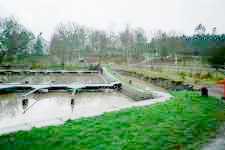
| 
| 
|
Land slide in Mem harbour autumn 2000
| When we get close to Tegelbruket lock the canal gets really narrow.
| One of the first locks from the Baltic sea.
|
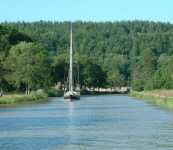
| 
| 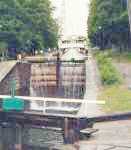
|
Idyllic canal
© Picture by Olle Sewerin, 2002
| Evening atmosphere
Ljungsbro and Berg
| Wilhelm Tham
during lockage in Borenshult
|
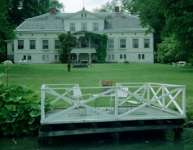
| 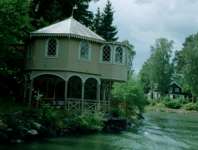
|
Brunneby mansion
| Pavilion along the canal
|
The western section
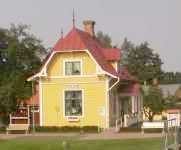
| 
| 
| 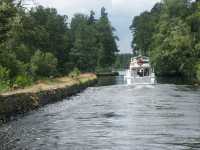
|
Pictures from Karlsborg
| Pictures from Forsvik canal
| Pictures from Dammsjön
| Pictures from Billströmmen
|
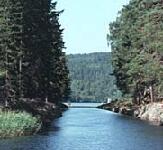
| 
| 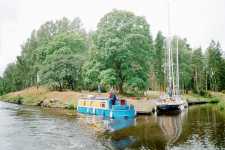
| 
|
Spetsnäs canal
| Leading walls in lake Viken
| The canal
at Lanthöjden
| Berg canal
|

| 
| 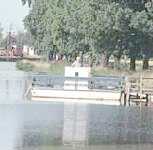
| 
|
Vassbacken guestharbour
| Canal idylls
| Handoperated cableferry in Töreboda
| The old warehouse in Lyrestad
|
Short history:
The famous bishop in Linköping, Hans Brask, in the 16th century proposed the building of a canal from the Baltic Sea to Kattegatt via lake Vättern and lake Vänern. King Gustav had plans like that too, but nothing happened until king Karl IX started the canalization of Göta Älv to connect lake Vänern to Kattegatt. - Read more about those works at the pages about Trollhätte kanal.
David af Thunberg made thorough investigations for Göta Canal at the end of the 18th century, but it was the baron and minister Baltzar von Platen that finally managed to complete the gigantic task of building this canal.
In 1806 von Platen presented a new investigation and in 1808 he marked the canal together with the English canal builder Thomas Telford. In 1809 parliament granted 1,2 million SEK and in 1810 parliament finally decided to build the canal.
The works started in Motala by lake Vättern on May 24th 1810. However the works were much more expensive than expected and took much longer time too. The total cost for the canal was estimated to 2,4 million SEK, but the final bill wrote 9 million SEK. This is equivalent to 2,4 billion SEK in the value of 1995. You also must have in mind that most work was performed by soldiers. All in all 58 000 soldiers were engaged from time to time.
On September 23rd 1822 the first part of the canal was officially opened. This was the part between lake Vänern and lake Vättern. Ten years later, at September 26th 1832, the part between lake Vättern and the Baltic Sea was opened for traffic and thus completed the canal.
The building of Göta Canal was done during a period of deep depression in Sweden. Baltzar von Platen had to spend most of his time raizing new funds and to calm down critics of the project.
Von Platen was an eminent technician who found many new solutions and tools that were used when building Göta Canal. He also founded Motala Workshop in 1822, a mechanic workshop that is regarded the cradle of Swedish mechanical industry. In spite of this, most work on the canal was manual diging with simple spades.
From the opening and the rest of the 19th century the canal had an immense impact for transport of both goods and passengers, but when railroads and roads were expanded by the turn to the 20th century the canal could no longer compete. A few commercial ships still used the canal during the 1960ies but since then it has been used solely by tourists. Today it is one of the most visited attractions in Sweden.
In 1906 1 600 steamers, 1 736 sailing ships and 2 092 barges passed the canal. During the 1990ies about 4 500 pleasure boats passed the canal every year and furthermore there are about 15 sightseeingboats running tours on the canal. The canal area is visited by about 2 million people every year.
The canal company's website.
Thomas Österlund has made a website mainly about the ships and the shipping companies that has operated on Göta Canal.
Linköping University has a webpage with lots of interesting information about Göta Canal.
| 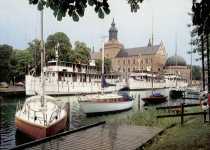
An old postcard from Vadstena
with the three steamers that belonged to
Rederi AB Göta Kanal moored.
|
Sources: Nordisk Familjebok 1928, Gert Åkesson - Göta Kanal 1979, STF:s årsbok 1995, Claes-G Palander - Kulturvandring i von Platens spår 1996, Ove Torgny Göta Kanal en resa på tvärs 2001, Petter Eklund - Göta Kanal Guide, Byggförlaget Stockholm 2002, and the canal company's website.
Do send comments or further information to Bosse Arnholm!
 Click here to get back to the startpage.
Click here to get back to the startpage.
This page was modified at